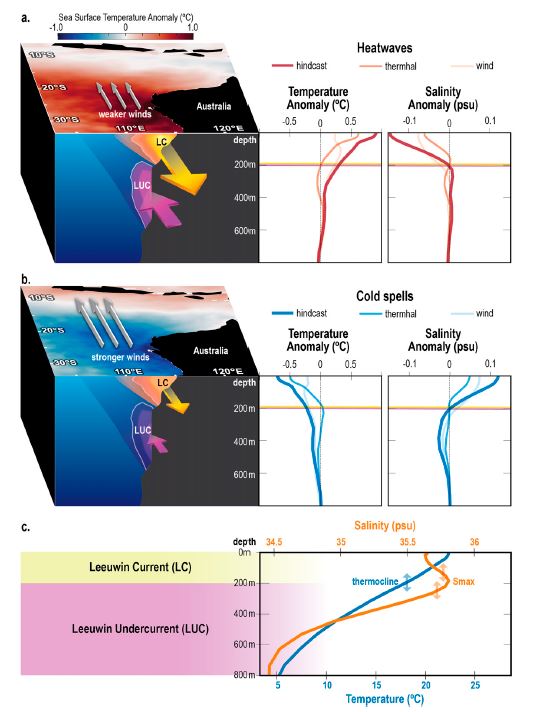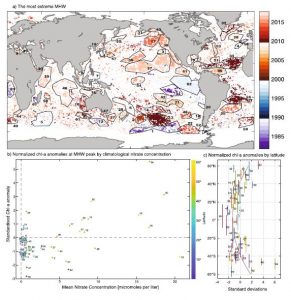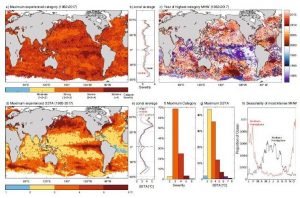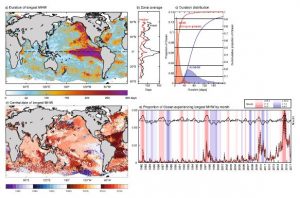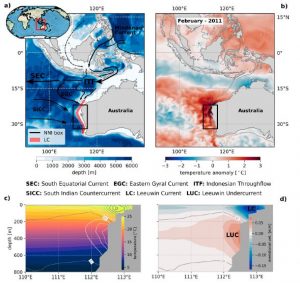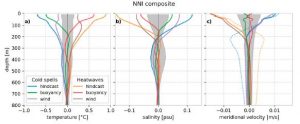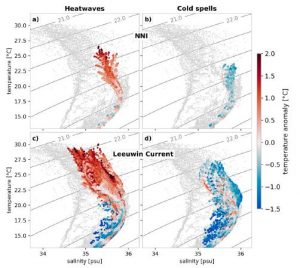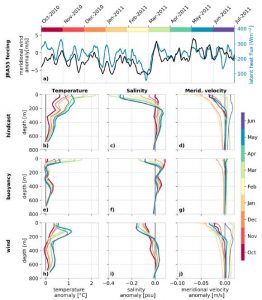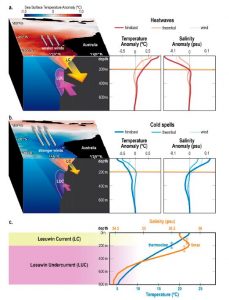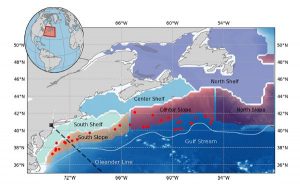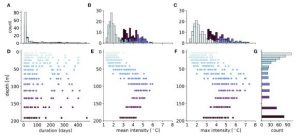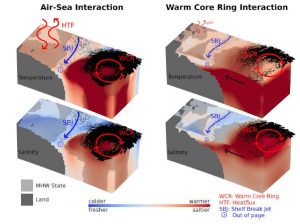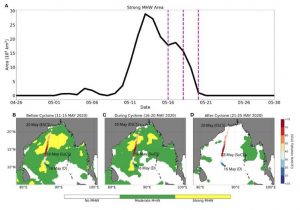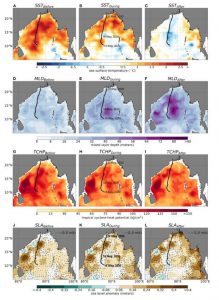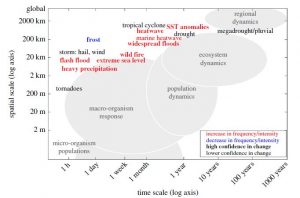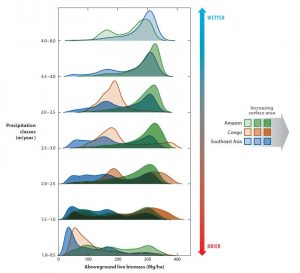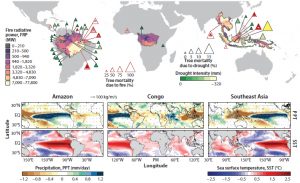Extreme Climate Events and Ecosystem Impacts
As detailed in Ummenhofer & Meehl (2017), robust evidence exists that certain extreme weather and climate events, especially daily temperature and precipitation extremes, have changed in regard to intensity and frequency over recent decades. These changes have been linked to human-induced climate change, while the degree to which climate change impacts an individual extreme climate event is more difficult to quantify. Rapid progress in event attribution has recently been made through improved understanding of observed and simulated climate variability, methods for event attribution and advances in numerical modelling. Attribution for extreme temperature events is stronger compared with other event types, notably those related to the hydrological cycle. Recent advances in the understanding of extreme climate events, both in observations and their representation in state-of-the-art climate models, open new opportunities for assessing their effect on human and natural systems. Improved spatial resolution in global climate models and advances in statistical and dynamical downscaling now provide climatic information at appropriate spatial and temporal scales. Together with the continued development of Earth System Models that simulate biogeochemical cycles and interactions with the biosphere at increasing complexity, these make it possible to develop a mechanistic understanding of how extreme climate events affect biological processes, ecosystem functioning and adaptation capabilities. Limitations in the observational network, both for physical climate system parameters and even more so for long-term ecological monitoring, have hampered progress in understanding bio-physical interactions across a range of scales. New opportunities for assessing how extreme climate events modulate ecosystem structure and functioning arise from better scientific understanding of extreme events coupled with technological advances in observing systems and instrumentation.
Marine Heatwaves
Prolonged high-temperature extreme events in the ocean, marine heatwaves (MHWs), can have severe and long-lasting impacts on marine ecosystems, fisheries and associated services. Sen Gupta et al. (2020) apply a MHW framework to analyze a global sea surface temperature product and identify the most extreme events, based on their intensity, duration and spatial extent. Many of these events have yet to be described in terms of their physical attributes, generation mechanisms, or ecological impacts. Our synthesis identifies commonalities between MHW characteristics and seasonality, links to the El Niño-Southern Oscillation, triggering processes and impacts on ocean productivity. The most intense events preferentially occur in summer, when climatological oceanic mixed layers are shallow and winds are weak, but at a time preceding climatological maximum sea surface temperatures. Most subtropical extreme MHWs were triggered by persistent atmospheric high-pressure systems and anomalously weak wind speeds, associated with increased insolation, and reduced ocean heat losses. Furthermore, the most extreme events tended to coincide with reduced chlorophyll-a concentration at low and mid-latitudes. Understanding the importance of the oceanic background state, local and remote drivers and the ocean productivity response from past events are critical steps toward improving predictions of future MHWs and their impacts.
In particular, very little is known about the depth structure of MHWs, which is the focus of a series of studies in the Indian Ocean and Northwest Atlantic: Along the coast of Western Australia, such oceanic MHWs are referred to as Ningaloo Niño and have had dramatic impacts on the ecosystem in the recent decade. Utilizing an eddy-active global ocean general circulation model, Ryan et al. (2021) investigate Ningaloo Niño and the corresponding cold Ningaloo Niña events between 1958 and 2016, with a focus on their depth structure. The relative roles of buoyancy and wind forcing are inferred from sensitivity experiments. Composites reveal a strong symmetry between cold and warm events in their vertical structure and associated large-scale spatial patterns. Temperature anomalies are largest at the surface, where buoyancy forcing is dominant, and extend down to 300-m depth (or deeper), with wind forcing being the main driver. Large-scale subsurface anomalies arise from a vertical modulation of the thermocline, extending from the western Pacific into the tropical eastern Indian Ocean. The strongest Ningaloo Niños in 2000 and 2011 are unprecedented compound events, where long-lasting high temperatures are accompanied by extreme freshening, which emerges in association with La Niñas, that is more common and persistent during the negative phase of the Interdecadal Pacific Oscillation. It is shown that Ningaloo Niños during La Niña phases have a distinctively deeper reach and are associated with a strengthening of the Leeuwin Current, while events during El Niño are limited to the surface layer temperatures, likely driven by local atmosphere-ocean feedbacks, without a clear imprint on salinity and velocity.
The Northwest Atlantic, which has exhibited evidence of accelerated warming compared to the global ocean, also experienced several notable MHWs over the last decade. Perez et al. (2021) analyze spatiotemporal patterns of surface and subsurface temperature structure across the Northwest Atlantic continental shelf and slope to assess the influences of atmospheric and oceanic processes on ocean temperatures. Here we focus on MHWs from 2015/16 and examine their physical drivers using observational and reanalysis products. We find that a combination of jet stream latitudinal position and ocean advection, mainly due to warm core rings shed by the Gulf Stream, plays a role in MHW development. While both atmospheric and oceanic drivers can lead to MHWs they have different temperature signatures with each affecting the vertical structure differently and horizontal spatial patterns of a MHW. Northwest Atlantic MHWs have significant socio-economic impacts and affect commercially important species such as squid and lobster.
Grosselindemann et al. (2022) utilize a global ocean circulation model with a high-resolution (1/20°) nest in the Atlantic to investigate the depth structure of MHWs and associated drivers on the Northeast U.S. continental shelf. It is shown that MHWs exhibit varying spatial extents, with some only occurring at depth. The highest intensities are found around 100m depth with temperatures exceeding the climatological mean by up to 7℃, while surface intensities are typically smaller (around 3℃). Distinct vertical structures are associated with different spatial MHW patterns and drivers. Investigation of the co-variability of temperature and salinity reveals that over 80% of MHWs at depth (>50m) coincide with extreme salinity anomalies. Two case studies provide insight into opposing MHW patterns at the surface and at depth, being forced by anomalous air-sea heat fluxes and Gulf Stream warm core ring interaction, respectively. The results highlight the importance of local ocean dynamics and the need to realistically represent them in climate models.
Rathore et al. (2022) provide new perspectives on the interactions between MHWs and tropical cyclones that could aid in improving the current understanding of compound extreme events that have severe socio-economic consequences in affected countries: Interactions are diagnosed between a MHW event and tropical super cyclone Amphan in the Bay of Bengal. In May 2020, an MHW developed in the Bay of Bengal driven by coupled ocean-atmosphere processes which included shoaling of the mixed layer depth due to reduced wind speed, increased net surface shortwave radiation flux into the ocean, increased upper ocean stratification, and increased subsurface warming. Ocean temperature, rather than salinity, dominated the stratification that contributed to the MHW development and the subsurface ocean warming that also increased tropical cyclone heat potential. The presence of this strong MHW with sea surface temperature anomalies >2.5℃ in the western Bay of Bengal coincided with the cyclone track and facilitated the rapid intensification of tropical cyclone Amphan to a super cyclone in just 24 h. This rapid intensification of a short-lived tropical cyclone, with a lifespan of 5 days over the ocean, is unprecedented in the Bay of Bengal during the pre-monsoon period (March-May). As the cyclone approached landfall in northern India, the wind-induced mixing deepened the mixed layer, cooled the ocean’s surface, and reduced sub-surface warming in the bay, resulting in the demise of the MHW.
Droughts and wildfires
As synthesized by Brando et al. (2019), tropical woody plants store∼230 petagrams of carbon (PgC) in their aboveground living biomass. This review suggests that these stocks are currently growing in primary forests at rates that have decreased in recent decades. Droughts are an important mechanism in reducing forest carbon (C) uptake and stocks by decreasing photosynthesis, elevating tree mortality, increasing autotrophic respiration, and promoting wildfires. Tropical forests were a C source to the atmosphere during the 2015-2016 El Niño-related drought, with some estimates suggesting that up to 2.3 PgC were released. With continued climate change, the intensity and frequency of droughts and fires will likely increase. It is unclear at what point the impacts of severe, repeated disturbances by drought and fires could exceed tropical forests’ capacity to recover. Although specific threshold conditions beyond which ecosystem properties could lead to alternative stable states are largely unknown, the growing body of scientific evidence points to such threshold conditions becoming more likely as climate and land use change across the tropics.
Further information
Brando PM, Paolucci L, Ummenhofer CC, Ordway EM, Hartmann H, Cattau M, Rattis L, Medjibe V, Coe M, and Balch J (2019). Droughts, wildfires, and forest carbon stocks: a pantropical synthesis. Annual Reviews of Earth and Planetary Sciences, 47, 555-581.
Grosselindemann H, Ryan S, Ummenhofer CC, Martin T, and Biastoch A. (2022). Marine heatwaves and their depth structures on the Northeast U.S. continental shelf. Frontiers in Climate, doi:10.3389/fclim.2022.857937. Reprint
Patrick SC, Martin J, Ummenhofer CC, Corbeau A, and Weimerskirch H. (2021). Albatrosses respond adaptively to climate variability by changing variance in foraging trait. Global Change Biology, 72, 4564-4574. Reprint
Perez E, Ryan S, Andres M, Gawarkiewicz G, Ummenhofer CC, Bane J, and Haines S. (2021). Understanding physical drivers of the 2015/16 marine heatwaves in the Northwest Atlantic. Scientific Reports, 17, doi:10.1038/s41598-021-97012-0. Reprint
Ryan S, Ummenhofer CC, Gawarkiewicz G, Wagner P, Scheinert M, Biastoch A, and Böning CW (2021). Depth structure of Ningaloo Niño/Niña events and associated drivers. Journal of Climate, 34, 1767-1788. Reprint
Sen Gupta A, Thomsen M, Benthuysen JA, Hobday AJ, Alexander LV, Oliver E, Burrows MT, Donat MG, Feng M, Holbrook NJ, Perkins-Kirkpatrick S, Moore PJ, Rodrigues R, Scannell HA, Taschetto AS, Ummenhofer CC, Wernberg T, and Smale DA. (2020). Extreme marine heatwaves – the most intense, largest, and longest events. Scientific Reports, doi:10.1038/s41598-020-75445-3. Reprint
Ummenhofer CC and Meehl GA (2017). Extreme weather and climate events with ecological relevance: a review. Philosophical Transactions of the Royal Society B, 372, doi:10.1098/rstb.2016.0135. Reprint
Ventura F, Sander N, Catry P, Wakefield E, De Pascalis F, Richardson P, Granadeiro JP, Silva M, and Ummenhofer CC. (2024). Oceanic seabirds chase tropical cyclones. Current Biology, doi:10.1016/j.cub.2024.06.022. Reprint

